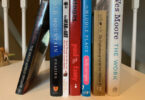We’ve referred to books as organic, because they contain the carbon molecule. The same components that make books, and derive from living things, can make books delicious to other life forms. So on some level, book manufacture is a recipe for disaster. Imagine your shelves as well-appointed tables, each volume a hearty meal.
Most destructive of all diners are the fungi, known interchangeably in the book world as mold and mildew. Their colonies generate spores, which reproduce in the presence of moisture and the absence of circulating air and controlled humidity and temperature.
Paper absorbs moisture, which to fungi announces the opening of a new restaurant, but one where the only reservations honored should be those we book lovers impose. It’s up to us to tell all comers that there are no tables available. For the presence of mold and mildew damages and often destroys books, and can also affect human health.
We cannot cover here all the ways to identify and combat fungi, but will outline the basics. For in-depth professional help, consult the Northeast Document Conservation Center.
We combined “biblio” from the Greek biblion for book, and the suffix “osis,” of Middle English, Latin, and Greek descent, which denotes an abnormal condition in medicine. The resulting bibliosis we define as the foul smell that can afflict books, a condition often treatable. The related bibliose refers to the sufferer, the malodorous book.
Cautious handling: Wear gloves, preferably disposable, and cover your nose and mouth with a surgical mask or respirator.
Identifying and removing fungi: The culprit may be dry and powdery (dormant) or soft and fuzzy (active) when you find it. The former may be removed by using a Document Cleaning Pad, a soft dry rag or sponge. The latter may benefit from exposure to the sun, though that same exposure may fade or otherwise debilitate the book. Try to work where fungi residue will not simply be removed from books to another host; you don’t want spores in your baseboards anymore than in your fine bindings. Avoid chemicals unless recommended by a professional. Freezing is safer by far, and effective: wrap books individually and tightly in scrupulously clean and dry plastic (we use Brodart’s 2-mil archival-quality bags; catalog number 38559001), and stow in the freezer for a few days. Fungal remains can then be gently brushed away, or blown away with a hairdryer set on low heat or gobbled up by a hand-held vacuum’s nozzle.
Isolate the afflicted: Uncertain how to proceed with a fungally afflicted book? Or just can’t get to the chore until tomorrow? Isolation, in plastic, from other books is imperative.
Monitor and control your books’ environment: Fungi flourish in warmth and moisture, in mini-tropic zones we may create for them by making ourselves comfortable. Low humidity (50 to 55 percent is a sensible goal) is essential to fungi control. And keep the thermostat around 68 degrees Fahrenheit; you’ll save your books and your money on heating bills. Routine cleaning of your store or home, especially where mold and mildew or other ultra-fine particles are concerned, is crucial. Use of a HEPA (high efficiency particulate) filter can make all the difference. A HEPA vacuum ideal for use around books is new to Brodart (catalog number 37194001).
There’s another point of mold-and-mildew interest to dealers and collectors, one that’s given us concern over the years and on which we think we’ve found a path somewhere between paranoia and careful observation. We receive books from all over the world, and we’re eager to add them to our inventory or personal libraries. But the patience we’ve learned from our dogs has made us wiser when we acquire books, especially old ones. We don’t know where they’ve lived, or under what conditions. Mold and mildew may be brewing even if initial examination shows us little or nothing to worry about. We isolate these newcomers, in plastic; most get the freezer treatment, followed by careful scrutiny and care as needed. Books received in a package that’s wet, or with any sign of dampness inside or out, should be quickly wrapped and frozen. We believe we’ve saved wider infestation by learning prudence.
With the holidays upon us, we want to end this column on a positive note. It’s book-shipping’s biggest season, and careful packing of all those fungi-free books is high on anybody’s (or any book’s) wish list.
Wrap books individually, using tissue paper or thin bubble or gift wrap; protect fine bindings with acid-free tissue paper. If gift cards acompany books, attach them outside the book’s wrapping.
A carton bigger than the book or books allows room for protective crumpled newspaper, packing peanuts, or bubble wrap. Delicate books may also travel more safely with cardboard sheets, cut larger than the books, secured around them. Always use strong cardboard protection around a book that is shipped in an envelope, even one that’s lined or padded. Try to resist the urge of convenience, and ship books with that fruitcake!




